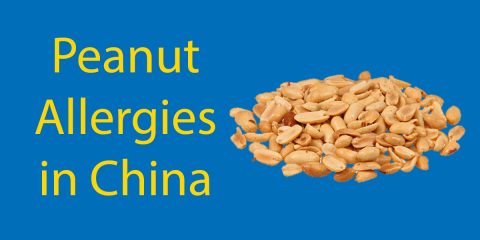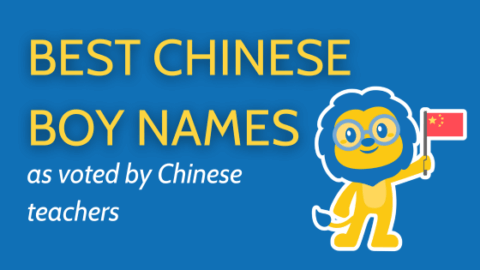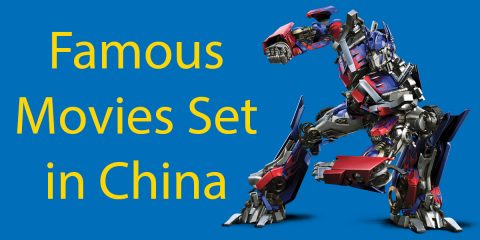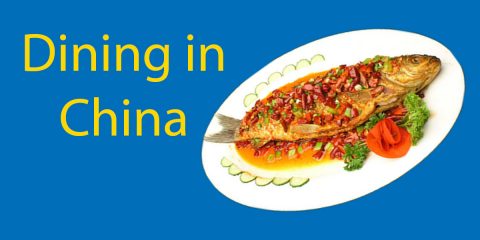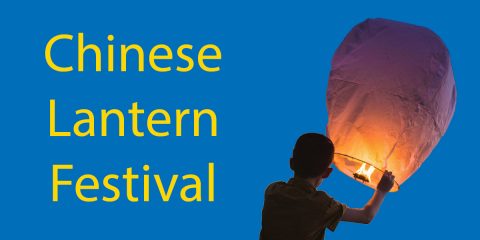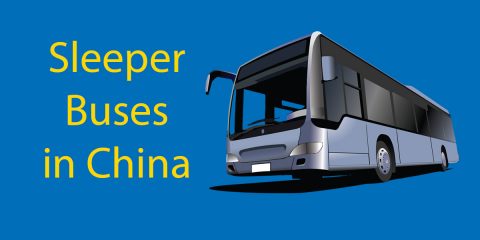Bubble Tea vs Boba // Our Complete Guide to Bubble Tea & How to Order
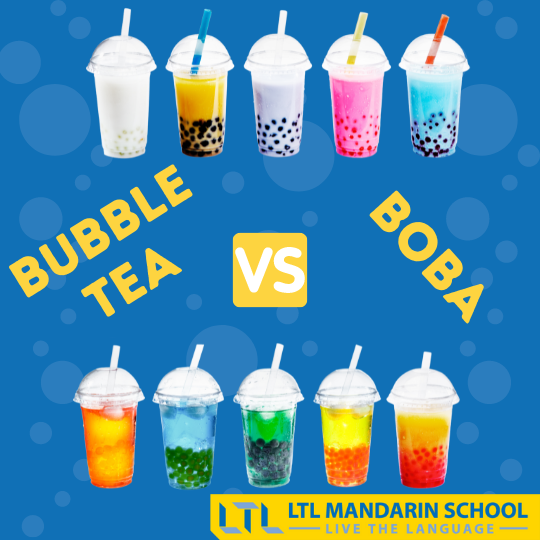
Any boba or bubble tea fans out there may have asked themselves bubble tea vs boba, what’s the difference?
Well, in short there is no difference, they are just different names for the same thing.
However, there is a slight technical difference between the two which we’ll get on to later.
Here is our complete guide to the most popular drink in Asia, how to order your very own, where to buy it, and we’ve even got a FREE cheat sheet to help you learn all the key bubble tea words!
Let’s go…
Bubble Tea vs Boba – What Is The Difference?
Bubble Tea vs Boba – History
Bubble Tea vs Boba – Rise In Popularity
Bubble Tea vs Boba – What It’s Like Today
Bubble Tea vs Boba – Ordering Guide
Bubble Tea vs Boba – Where Can I Buy A Boba?
Bubble Tea vs Boba – FAQ’s
Check out our bubble tea cheat sheet below!!
👇👇👇
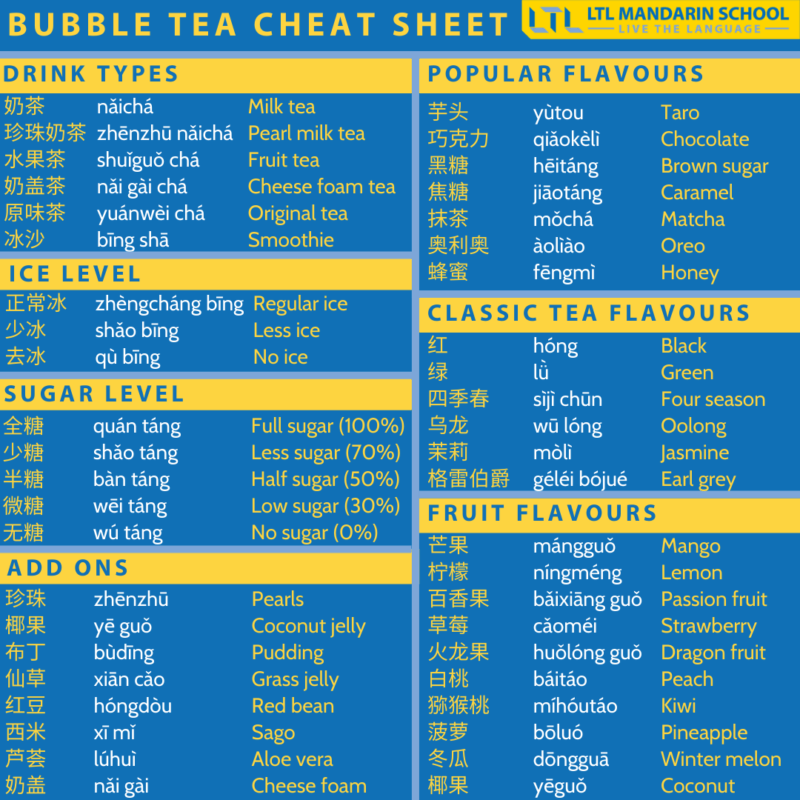
Bubble Tea vs Boba – What is the Difference?
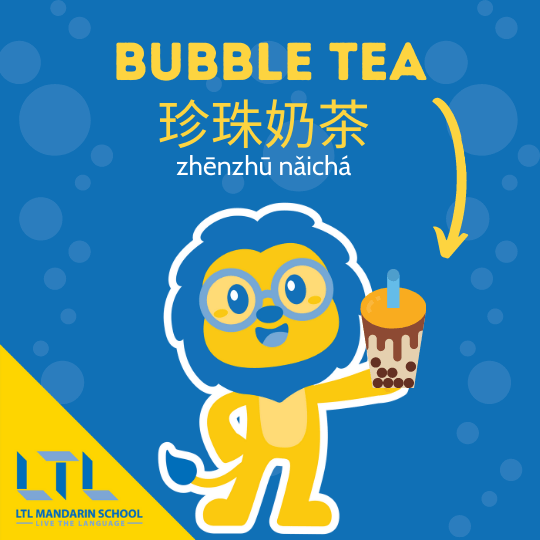
When someone talks about bubble tea or boba they’ll be referring to the popular Taiwanese fruit or milk tea drink with tapioca pearls.
There are also a couple of other names you may have heard it called:
- Pearl Milk Tea
- Milk Tea
- Pearl Tea
- Tapioca Tea
They all refer to the same drink essentially.
The Chinese name for the drink is 珍珠奶茶 zhēnzhū nǎichá. 珍珠 zhēnzhū is pearl, 奶 nǎi is milk and 茶 chá is tea.
Now if we want to get down to the technicalities of bubble tea vs boba then bubble tea refers to the drink and boba actually refers to the tapioca pearls that are added to the drink.
However, boba has become synonymous with the drink itself so the two names can be used interchangeably.
Interestingly in the United States there is actually a split between the two coasts for which name is more popular with the East preferring bubble tea and the West preferring boba. I myself as a Brit have always heard the drink referred to as bubble tea or pearl milk tea.
Also contrary to popular belief, the bubble in bubble tea doesn’t refer to the tapioca pearls but actually to the bubbles formed on top of the drink when it’s mixed.
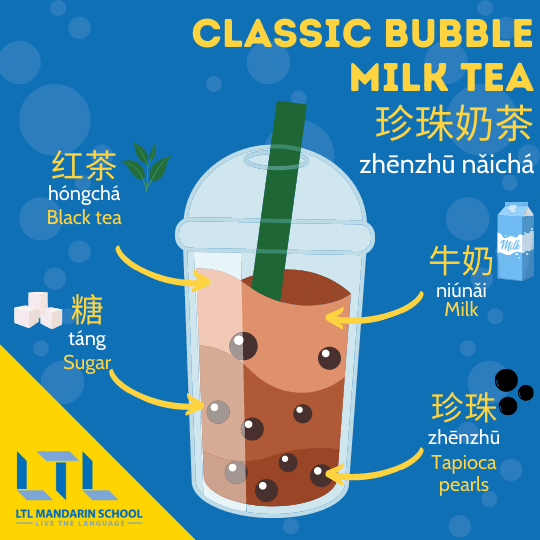
So what is actually in a bubble tea?
The classic milk bubble tea is made up of:
- Black tea
- Creamer or milk
- Sugar or syrup
- Tapioca pearls
The drink also normally has ice (traditionally shaved ice), however some variations such as the Hong Kong milk tea are served hot instead.
Bubble Tea vs Boba – History
Bubble tea first emerged in Taiwan during the 1980s.
Prior to this sweet milk tea (usually made with powdered creamer) was already a popular drink and tapioca pearls and shaved ice were common Taiwanese desserts.
At some point in time someone decided to combine all three: milk tea, tapioca pearls and shaved ice to create the drink we love today, however who actually came up with the idea is a hotly contested debate.
There are two popular competing stories for who invented bubble tea with two teahouses in Taiwan both laying claim to its invention
- The Hanlin Tea Room (翰林茶館 hànlín cháguǎn)
- Chun Shui Tang Tea Room (春水堂人文茶館 chūnshuǐ táng rénwén cháguǎn)
The Hanlin Tearoom states that they invented bubble tea in 1986 when the teahouse owner Tu Tsong-he saw some tapioca balls for sale on the street and felt a sudden inspiration to go home and add them to tea.
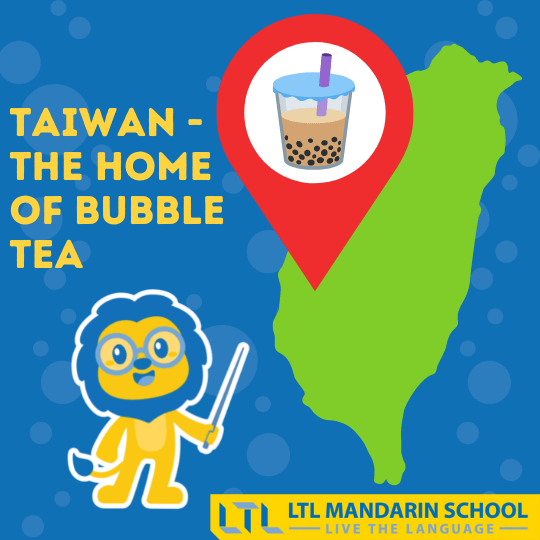
Contrary to this, Chun Shui Tang Tea Room claim that they invented bubble tea in 1988.
In the 1980s this tea room had already begun serving tea cold after the owner Liu Han-Chieh went on a visit to Japan and saw them serving coffee this way.
Then in 1988 during a staff meeting the company’s product development manager Lin Hsiu Hui added some tapioca balls to her tea then encouraged others to try it.
During the late 1980s the two tea rooms spent a lot of time suing each other over who came up with the beverage, but it was never settled and both continue to claim themselves as the rightful inventors.
However, there is also a third possible theory which is that bubble tea was actually invented by street vendors in one of Taiwan’s famous night markets.
Which story do you believe? Let us know in the comments below.
Where the Name Boba Came From
Although there is no consensus on who invented bubble tea there is a consensus to where the name boba came from.
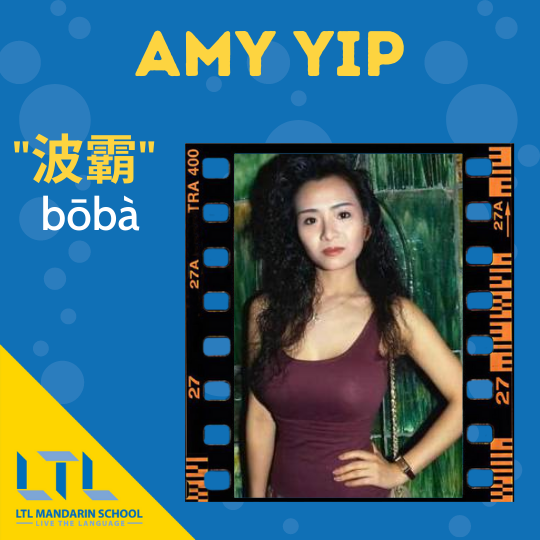
Now, most people think that the name boba came about because it sounds similar to bubble, but actually this is completely wrong!
The name boba actually relates to famous Hong Kong Cinema actress Amy Yip who was a leading sex symbol in the 1980s and 1990s. Amy Yip’s nickname was Boba (波霸 bōbà) which roughly translates to “champion of breasts”.
A hawker in Tainan decided to start selling bubble tea with larger larger black tapioca balls than other teashops and he started referring to them as boba to differentiate them.
Bubble Tea vs Boba – Rise in Popularity
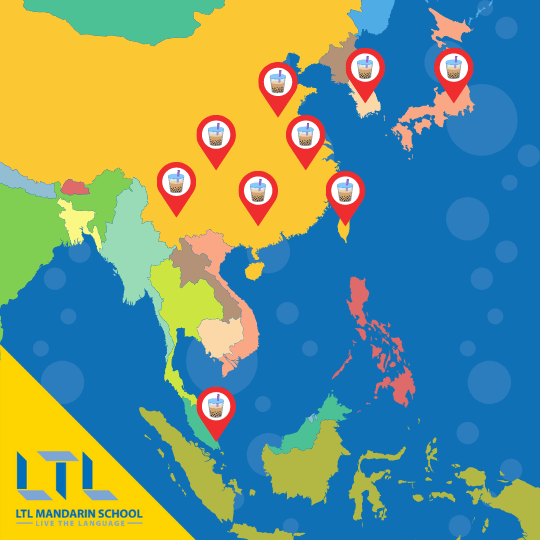
In recent years bubble tea has become somewhat of a global craze. You can now find a bubble tea shop in countless city’s all over the globe.
Bubble tea shops aren’t just popping up in bigger cities like London or New York but even in smaller places too.
My own hometown Bath, a very small city in the UK, even has multiple bubble tea shops so you can really see how much of a global trend it has become!
So when and where did it first start becoming popular outside of Taiwan?
Well it should come as no surprise that bubble tea first started to grow popular across East and Southeast Asia, quickly spreading from Taiwan to Hong Kong, mainland China, Korea, Japan, Singapore Malaysia etc.
During the 1990s the drinks popularity grew and many places such as Hong Kong put their own twist on the drink combining the tapioca pearls with their traditional Hong Kong milk tea.
Bubble Tea’s Spread Worldwide
Bubble tea then spread to North America in the 1990s through immigrant communities.
The first bubble tea shop was set up in the US was set up in California by Taiwanese immigrants and soon bubble tea chain shops started popping up in the late 1990s and early 2000s.
However, it was in the 2010s that bubble tea craze really got going in the US. It became hugely popular among the Asian-American community, with many Asian-Americans choosing to socialise and hang out in bubble tea shops.
Then, in 2013 the Fung Brothers released an amusing music video called ‘Bobalife’ to articulate the experience of what bubble tea meant for the Asian-American community.
The video went viral and many credit this with spreading bubble tea’s popularity across the US and made more people choose to explore bubble tea.
From the US it soon become popular in other parts of the world such as Europe, with bubble tea shops becoming common features of China Towns all over the world.
Today, there are now multiple global bubble tea chains and you’ll find them across many cities.
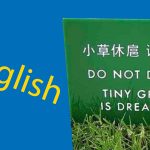
Chinese + English = Chinglish 😲 You Must See To Believe
Chinglish – Sometimes you have to see it to believe it. You will be amazed at some of these language mishaps that are made when translating to Chinese.
What it’s Like Today
As can be expected, over the years bubble tea has gone through many changes and become much more than just a simple milk tea drink with tapioca pearls and ice.
Nowadays, there are a multitude of different flavours and variations.
Boba also doesn’t only appear in the bubble tea drink but as a topping on other food such as pancakes.
Ok, that seems pretty normal considering tapioca balls were already a dessert in Taiwan, however some verge on the downright bizarre – boba pizza anyone!?
A popular brunch place called The Rug in Beijing has actually added boba to noodles, hot cakes and cocktails.
So let’s have a look at some of the most popular flavours and variations you’ll find today.
Brown Sugar Bubble Tea (黑糖珍珠奶茶 hēitáng zhēnzhū nǎichá)
A twist on the classic bubble tea, the brown sugar bubble tea, has started to become popular since around 2018.
Creamer is swapped out for real milk and brown sugar syrup or natural brown sugar is added.
This creates some beautiful marbling effects in the drink which are very popular to Instagram.
You can also add brown sugar boba to make it even more decadent.
Taro Bubble Tea (芋头珍珠奶茶 yùtou zhēnzhū nǎichá)
Taro has long been popular in desserts across Asia, so for those familiar with Asian desserts it seems like a no brainer that it would be added to bubble tea.
For those who don’t know taro is a sweet root vegetable similar to sweet potato that is a brown-lilac colour.
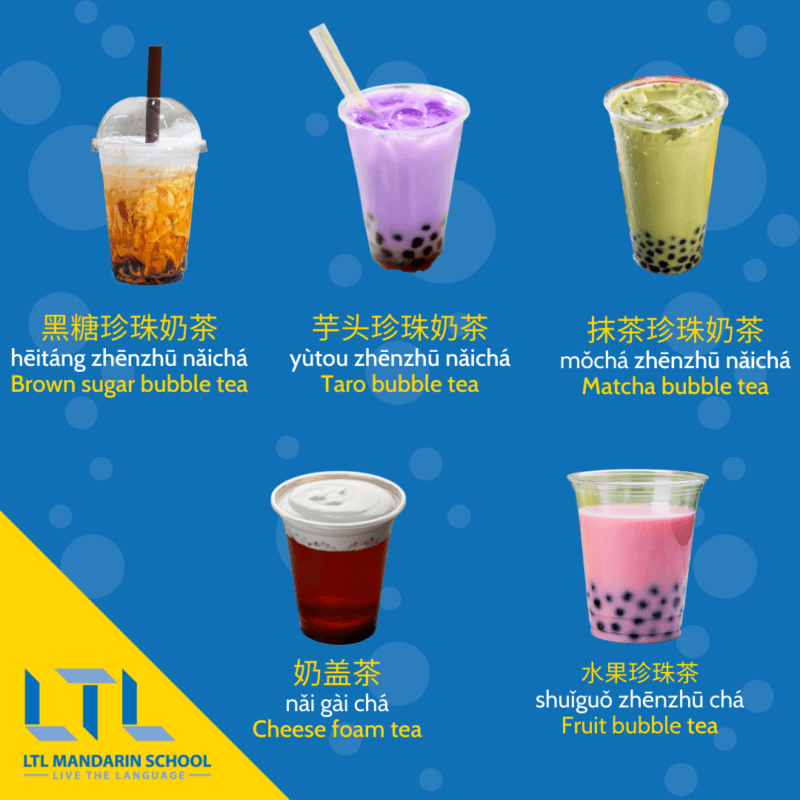
Matcha Bubble Tea (抹茶珍珠奶茶 mǒchá zhēnzhū nǎichá)
Just like taro, matcha has also been a firm favourite flavour in Asian drinks and desserts so matcha bubble tea should come as no surprise.
Cheese Foam Tea (奶盖茶 zhēnzhū nǎi gài chá)
A more recent addition to the bubble tea world we have cheese foam bubble tea, sometimes also referred to as cream cheese bubble tea.
First starting at a Taiwanese night market stand where they combined powdered cheese with salt, whipping cream and milk to form a frothy layer on top of the tea.
The frothy layer is called 奶盖 nǎi gài which literally translates to “milk lid”.
These have now been popping up all over China and aren’t just limited to bubble tea shops.
Many coffee chains are now also selling various drinks, such as lattes that also come topped with the milk cheese foam.
Fruit Tea and Jellies
A great option for anyone who isn’t a fan of milk tea, there are fruit tea or fruit juice variations of bubble tea also available.
Now these can be served with boba, however another popular option is to have grass jelly (仙草 xiāncǎo) or aiyu jelly (愛玉冰 àiyùbīng) added to the drink.
Coffee and Other Drinks
A lot of bubble tea places will also do coffee, hot chocolate etc. so you can accessorise your latte, mocha or whatever your go to coffee is with some tapioca pearls.
Many places will also offer smoothie or milkshake type drinks too, with some popular example flavours being Oreo or pudding.
Very brightly coloured, vibrant bubble tea flavours have also become popular with a large part of this being because they’re so Instagramable!
Healthy Variations
It should come as no surprise given the amount of fat and sugar in a bubble tea that they aren’t particularly healthy.
However, with health and wellbeing becoming more of a global trend, bubble tea is also adapting to new consumer wants.
May bubble tea stores will offer low calorie options with less sugar and skimmed milk. Many other places are also offering non-dairy milk alternatives such as oat milk or soy.
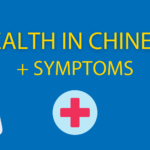
Health in Chinese 👩⚕️ Beginner’s Guide to Symptoms in Chinese
We’ve prepared a very useful list to reassure your about health in Chinese. Check out the most common symptoms in Chinese, and put your mind at ease.
A Guide to Ordering Bubble Tea
Now we’ve looked at all the ins and outs of bubble tea vs boba, the history and varieties next up is the all important ordering guide.
Have you every gone into a bubble tea shop, looked at the menu and felt completely overwhelmed or confused by all the different options?
Well then we have everything you need with our complete guide to ordering boba, plus a super useful cheat sheet!
Step #1 – Choose Your Flavour
First off what kind of bubble tea do you want?
Most menus will be split into different sections such as: bubble milk tea, classic tea, fruit tea etc.
The cashier may start of by asking you:
今天要什么?Jīntiān yào shénme? – What do you want today?
You can reply:
我要一杯XX珍珠奶茶 wǒ yào yī bēi XX zhēnzhūnǎichá – I want a cup of XX bubble tea. (Put your preferred flavour where XX is).
Here are some popular different types:
| English | Chinese | Pinyin |
|---|---|---|
| Milk tea | 奶茶 | nǎichá |
| Pearl milk tea | 珍珠奶茶 | zhēnzhū nǎichá |
| Fruit tea | 水果茶 | shuǐguǒ chá |
| Cheese foam tea | 奶盖茶 | nǎi gài chá |
| Original/Classic tea | 原味茶/经典 | yuánwèi/jīngdiǎn chá |
| Smoothie | 冰沙 | bīng shā |
Next up let’s look at some popular different flavours:
| English | Chinese | Pinyin |
|---|---|---|
| Taro | 芋头 | yùtou |
| Chocolate | 巧克力 | qiǎokèlì |
| Brown sugar | 黑糖 | hēitáng |
| Caramel | 焦糖 | jiāotáng |
| Matcha | 抹茶 | mǒchá |
| Oreo | 奥利奥 | àolìào |
| Honey | 蜂蜜 | fēngmì |
For classic tea lovers, here are some of the most popular different types of tea flavours you’ll see:
| English | Chinese | Pinyin |
|---|---|---|
| 红 | hóng | Black |
| 绿 | lǜ | Green |
| 四季春 | sìjì chūn | Four season |
| 乌龙 | wū lóng | Oolong |
| 茉莉 | mòlì | Jasmine |
| 格雷伯爵 | géléi bójué | Earl grey |
Finally, if you’re not too familiar with your fruit in Chinese, then here are some of the most common fruit flavours you’ll see:
| English | Chinese | Pinyin |
|---|---|---|
| Mango | 芒果 | mángguǒ |
| Lemon | 柠檬 | níngméng |
| Passion fruit | 百香果 | bǎixiāng guǒ |
| Strawberry | 草莓 | cǎoméi |
| Dragon fruit | 火龙果 | huǒlóng guǒ |
| Peach | 白桃 | báitáo |
| Kiwi | 猕猴桃 | míhóutáo |
| Pineapple | 菠萝 | bōluó |
| Winter melon | 冬瓜 | dōngguā |
| Coconut | 椰果 | yēguǒ |
Step #2 Choose Your Ice and Sugar Level
After you’ve chosen what flavour or variety of bubble tea you want, you’ll need to decide what ice and sugar level you want.
How many different ice and sugar levels are available may differ from place to place, however these should be the general options:
Ice
- Lots of ice 多冰 duō bīng
- Regular ice 正常冰 zhèngcháng bīng
- Less ice 少冰 shǎo bīng
- No ice 去冰 qù bīng
- Hot 热 rè
Sugar
- Full sugar (100%) 全糖 quán táng
- Less sugar (70%) 少糖 shǎo táng
- Half sugar (50%) 半糖 bàn táng
- Low sugar (30%) 微糖 wēi táng
- No sugar (0%) 无糖 wú táng
The cashier will ask you:
“甜度、冰塊 (块)?” (tiándù, bīngkuài?) “Sweetness and ice?”
Then you would reply:
“X糖、X冰。” (X táng, X bīng). “X-sugar, X ice”.
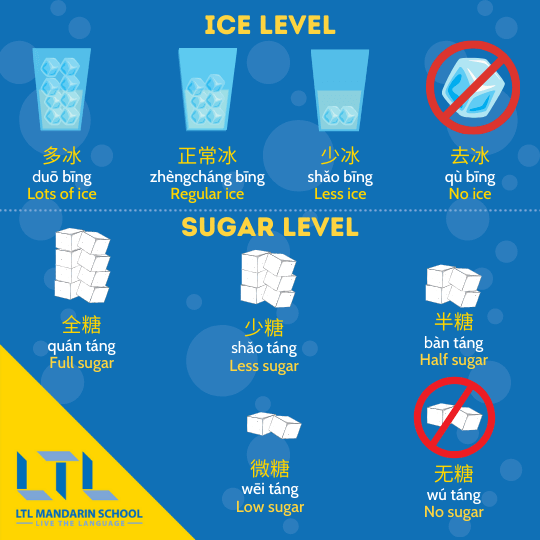
Step #3 – Add Ons/Toppings
Lastly we have step number three: add-ons/toppings.
These refer to the same things, just some shops choose to name the category differently.
As many of these “toppings” actually sink to the bottom of the cup, add-ons may be more of an accurate way to describe them.
| English | Chinese | Pinyin |
|---|---|---|
| Tapioca pearls | 珍珠 | hēnzhū |
| Coconut jelly | 椰果 | yē guǒ |
| Pudding | 布丁 | bùdīng |
| Grass jelly | 仙草 | xiān cǎo |
| Red bean | 红豆 | hóngdòu |
| Sago | 西米 | xī mǐ |
| Aloe vera | 芦荟 | lúhuì |
| Cheese foam | 奶盖 | nǎi gài |
Step #4 – Download this Cheat Sheet!
In case you missed it earlier, just a reminder to download and save out handy cheat sheet to your phone so that you’ll always be able to order bubble tea without a hitch in China! 👇

Where To Buy Your Boba
So now you what what Boba is and how to order it, but where the heck do you get one of these delicious cups of goodness?
Well, as already mentioned, Bubble tea is becoming more and more commonly seen worldwide which is great news for all of us, but there remain the best places!
For example – if you want a good Pizza, you go to Italy! Want to sink a pint of Guinness? You get yourself to Ireland.
On that note…
Option 1: Go to China! Buy Anywhere!
If you already live in China, then you (should) know that milk tea is everywhere!
Planning on visiting China soon? Don’t miss out on this magical beverage.
Common brands can be found in shopping malls across the country.
But the golden question – where to buy milk tea in China? Here are three must try brands!
Three of the most commonly found brands are Happy Lemon, Yi Dian Dian and Coco (as featured in the video above).
Everyone has their own preference, but generally speaking, the basic milk tea recipe and pricing of these chains is similar and it’s the mix-ins, packaging, and other small details that drive each milk tea aficionado to their own brand loyalties.
Option 2: Chinatown
As milk tea becomes increasingly popular in countries outside of Asia, Chinese restaurants and Chinatown’s are eager to provide this sweet drink to the increasing hordes of milk-tea hungry clientele.
If you live near a major metropolitan area, you can probably find milk tea in the local Chinatown.
Personally speaking, the milk teas I’ve consumed in Chinatown’s abroad are a bit different from the standard milk tea recipe offered by chains in Greater China.
It’s a bit sweeter and there tend to be more fruit flavours offered with fewer mix-ins.
But, for the uninitiated or desperate, the milk teas available in Chinatowns are a good starting point.
If you live near a stellar Chinatown like the ones in London, New York or Los Angeles, you can even find some Chinese chains popping up.
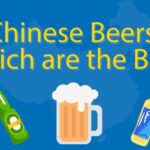
The Complete Guide to Chinese Beer // Pick Your Fave
Chinese Beer // A simple guide to all the beers you can enjoy in China. BONUS – Learn about all the breweries and see which Chinese beers are the best rated
Option 3: Make It Yourself
Put on your DIY chef hat and get the milk boiling as you follow this simple recipe, originally titled 手煮奶茶, from contributor “密思 Michelle” in Chinese cooking app 下厨房.
Chinese study tip – All of the Chinese directions have been preserved from the original recipe.
If you enjoy reading more of this type of recipe and practicing your upper-intermediate to advanced reading skills, considering downloading the app and trying more recipes yourself!
For beginners, see which words you can pick out from this article. I bet you can find 红茶 (black tea) and 牛奶 (milk)!
Milk Tea Recipe
| 用料 | Ingredients |
|---|---|
| 红茶叶— 3 tbsp可按照口味斟酌 | Black tea – 3 tablespoons (or according to your own taste preferences) |
| 鲜牛奶 — 2 cup (此方大概做一人份奶茶) | Milk – 2 cups (This makes about one serving of milk tea) |
| 白砂糖 – 少许 (我比如不能吃甜这个比例1tsp已经是极限所以我一般都不放糖了) | White sugar – use minimally, as needed (For example, I can’t eat very sweet foods; 1 tsp is already my upper limit! Normally I don’t put in any sugar) |
*Culture note: Take this milk tea recipe’s sugar recommendations with a grain of salt (or, perhaps more appropriately, a grain of sugar).
Consumption of the large amounts of sugar common in Western diets is only recently becoming more common in China.This means that many people are more sensitive to very sweet foods, a definite culture difference.
| Chinese – Step by Step | English – Step by Step |
|---|---|
| 步骤1 白糖放入无水的锅里 中火加热至成琥珀色 | Step 1 Place white sugar into a waterless pan. Cook on medium heat until the sugar turns an amber color. |
| 步骤2 往锅中倒入牛奶 并将茶叶倒进牛奶中焦糖会突然结块但是慢慢会化开 | Step 2 Add milk to the caramelized sugar in the pan. Then, add tea leaves into the milk. The caramelized sugar will suddenly form hardened crystals but these will slowly dissolve as you continue stirring. |
| 步骤3 起初茶叶会浮在牛奶上 但是随着它吸饱水它自己会浸入到牛奶中 | Step 3 Although the tea leaves will originally float to the top of the milk, keep stirring until the tea leaves absorb water and sink into the milk. |
| 步骤4 用木棒捻茶叶就是用一头杵茶叶并伴随捻的动作 目的是让茶叶的味道完全散发出来。 用木棒上下碾压。 如果喜欢奶味重 可以少煮些时间 如果喜欢茶味重 就多捻一些时间 | Step 4: Use a wooden spatula to stir and crush the tea leaves. The goal is to release the flavor of the tea leaves into the milk. If you like a stronger milk flavor, you can boil the milk for a shorter time. If you like a stronger tea flavor, you can boil and crush the tea leaves for longer. |
| 步骤5 煮至奶茶颜色不再变 用漏勺隔住茶叶 离火倒入杯中 | Step 5: Boil until the color of the milk stabilizes. Use a slotted spoon to remove the tea leaves.Remove from heat and pour into a glass. |
| 步骤6 冰奶茶的做法:将晾冷的奶茶倒进冰格放入冷冻室。冻成冰后放入鲜煮的奶茶中,让二者融为一体。味道丝毫不减,更适合炎热的夏日 | Step 6: Iced milk tea recipe variation: To make iced milk tea, pour cooled down milk tea into an ice cube tray and place in the freezer. Once frozen, remove and add to unfrozen milk tea. The two will mix together and make a nice, chilled milk tea. The flavor stays strong. A great drink for a hot summer day! |
Common mix-ins include: tapioca balls, grass jelly, red beans, and grains such as oats and Job’s tears.
Try this milk tea recipe out and impress your friends with your amazing Chinese cooking abilities.
And there you have it! Your complete guide to bubble tea vs boba, including how to order it and where to find it! Aren’t we good to you!
So, what is your favourite bubble tea flavour? Did you already know what the technical difference was between bubble tea vs boba?
Let us know in the comments below and thanks for reading.
Bubble Tea vs Boba – FAQs
Are bubble tea and boba the same?
The short answer is yes, when people say they want a bubble tea or boba they’re referring to the same thing.
However, technically the difference is that bubble tea refers to the drink in general whereas boba refers to the tapioca pearls themselves.
Why is bubble tea called boba?
Bubble tea is called boba, because boba refer to the tapioca pearls in bubble tea.
The name boba then became a way to also refer to the drink itself.
Are tapioca pearls the same as boba?
Yes tapioca pearls are boba, however often when people use the word boba they are referring to the bubble tea drink in general rather than specifically the tapioca pearls.
Does bubble mean boba?
No bubble doesn’t mean boba.
Boba (波霸 bōbà) is originally a nickname for Amy Yip and roughly translates to “champion of breasts”.
This term was coined by a Taiwanese street vendor to refer to the tapioca pearls in bubble tea.
What are some famous bubble tea brands?
There are plenty but three of the finest are Happy Lemon, Yi Dian Dian and Coco.
Is bubble tea healthy?
Generally bubble tea isn’t very healthy as it has a lot of fat and sugar in it, however, there are some healthy variations of the drink.
Want more from LTL?
Want to learn Chinese from the comfort of your own home? Then our 24/7 online Chinese lessons might be the thing for you.
We offer a 7 day free trial to all new online students where you can study Mandarin 24/7.
Come and check it out free of charge and see what you think!
If you wish to hear more from LTL Language School why not join our mailing list?

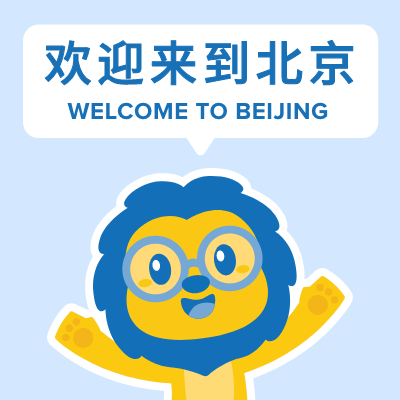
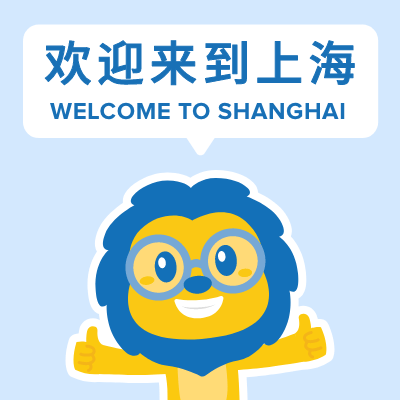
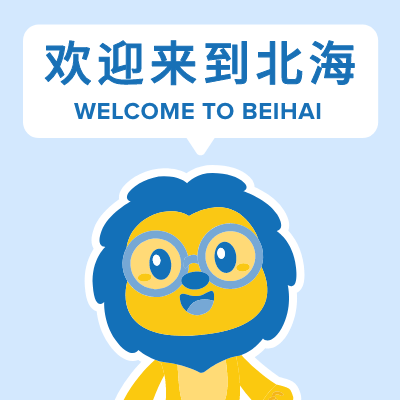
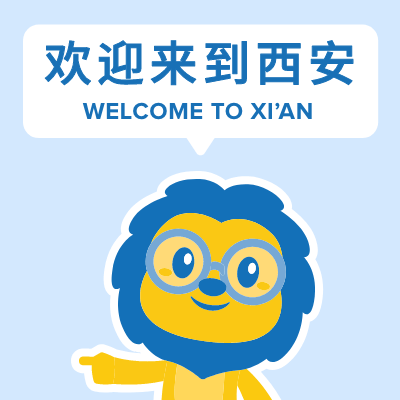
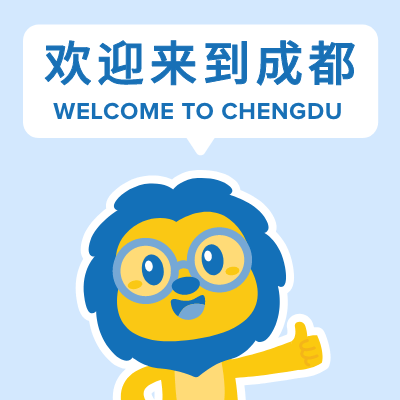
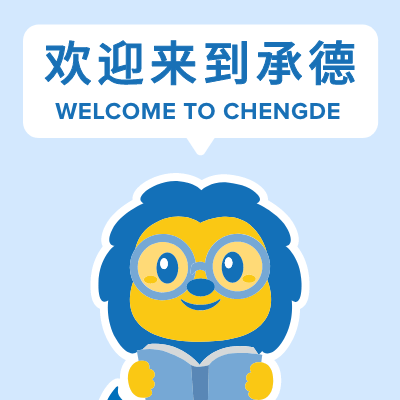
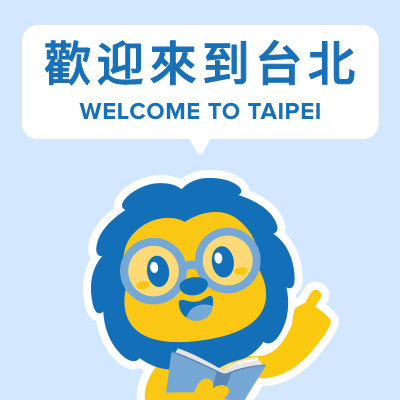
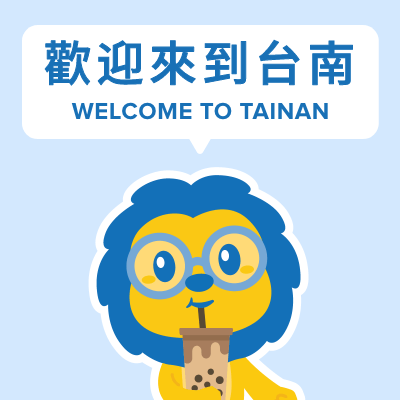
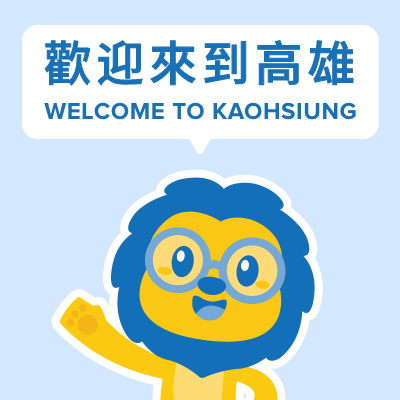
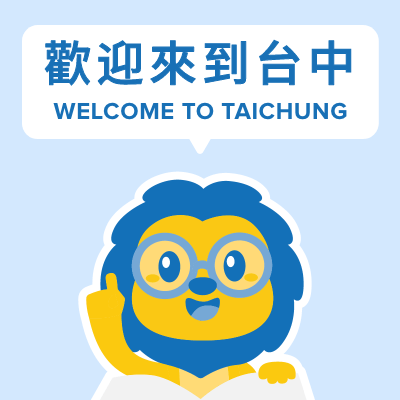
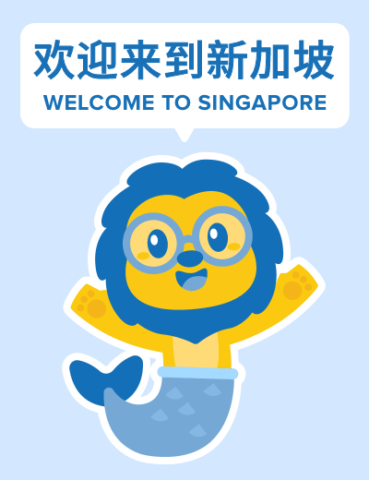

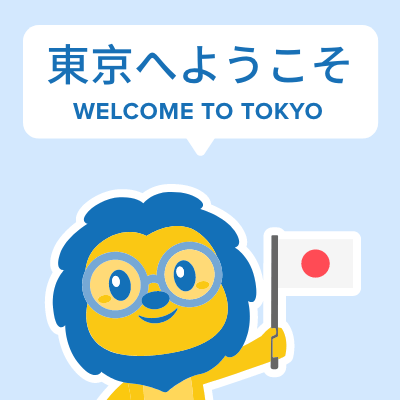
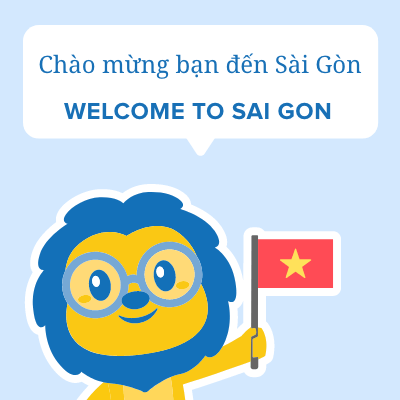

 Hi, my name is Manuel! I am from Spain and I am a Student Advisor at LTL. I’m now based at our Seoul School after living 3 years in Taipei.
Hi, my name is Manuel! I am from Spain and I am a Student Advisor at LTL. I’m now based at our Seoul School after living 3 years in Taipei. Hi, my name is Mojca! I am from Slovenia in Europe and I work as a student advisor at our Shanghai school.
Hi, my name is Mojca! I am from Slovenia in Europe and I work as a student advisor at our Shanghai school.
